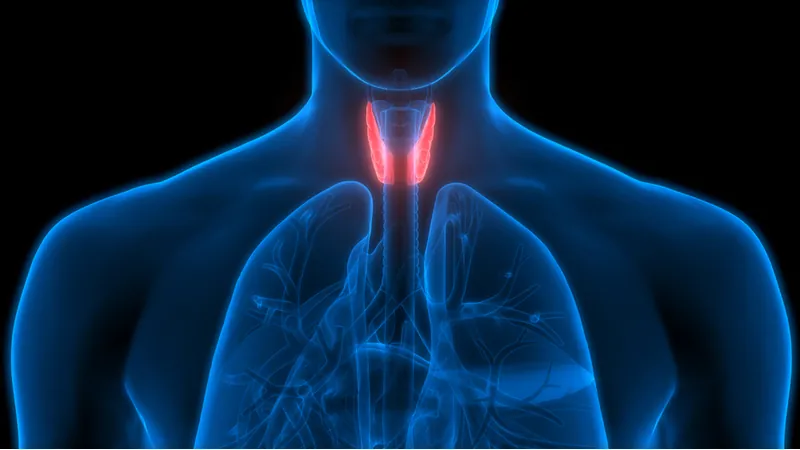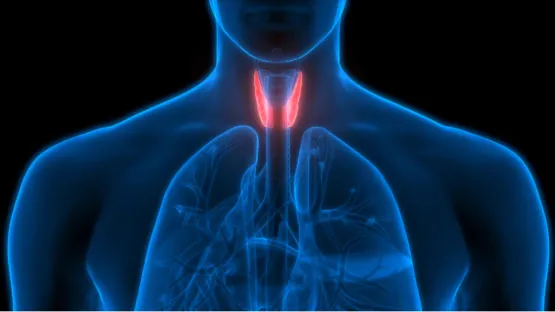In a new study published in Stem Cell Reports, researchers have developed organoids to replace thyroid function [1]. If this approach is fully fleshed out and successfully brought to the clinic, it may become a true cure for hypothyroidism.
A common but harmful affliction
Hypothyroidism is one of the most common afflictions around the world, and its symptoms include depression, anxiety, weight gain, constipation, and fatigue. The current standard of care, a pharmaceutically delivered thyroid hormone known as levothyroxine, does not wholly treat hypothyroidism in 5 to 10 percent of sufferers [2].
As with a great many disorders, hypothyroidism increases with age [3]. In subclinical hypothyroidism, the amount of circulating thyroid-stimulating hormone (TSH) goes up, while the factors produced by the thyroid go down or remain stable; the thyroid requires additional stimulation just to retain its function. This condition is common in older people, as their levels of TSH are, on average, considerably higher than the youthful norm.
Enter the organoid
The current pharmaceutical approach to hypothyroidism is to simply replace at least one of the hormones that the thyroid produces. However, the researchers of this study have created small artificial organs (organoids) that live within tissue and create such hormones themselves. If their approach can go through the development and human clinical trial process, the resulting therapy could potentially function exactly as a human thyroid does, removing the need for pharmaceutically created hormones.
These organoids were not created from specific populations of stem cells. As the researchers explain, they are not yet able to identify, cultivate, and produce individual thyroid stem cells at all. They are also unsure whether or not their culturing medium causes differentiated thyroid cells to revert to a stem cell state; which would represent the same regenerative capacity that liver tissue has. The results of this experiment are shown through aggregation and analysis of the organoids as a whole rather than the specific identification of cells.
Fortunately, these thyroid cells were not shown to generate tumors, which is a frequent problem with regenerative approaches. On the other hand, the amount of actual thyroid hormones generated by these organoids was insufficient to treat hypothyroidism in thyroid-damaged mice. The researchers hypothesize that this was due to the lack of blood vessels connecting to the organoids, and this lack of vascularization is also a commonly known issue with these sorts of regenerative approaches.
The researchers also note that there is a significant discrepancy between murine and human tissue. After one week, less than a sixth of mouse cells remained in proliferative phases of the cellular cycle, while more than a third of human cells stayed in these phases. Such discrepancies between mice and humans are not uncommon in aging research, as our longer lifespans mean that we have regenerative mechanisms that mice lack. In this case, the researchers were able to test human organoids in mice through xenotransplantation.
AbstractMurine and human thyroid-derived cells were cultured as organoids capable of self-renewal and which expressed proliferation and putative stem cell and thyroid characteristics, without a change in the expression of thyroid tumor-related genes. These organoids formed thyroid-tissue-resembling structures in culture. (Xeno-)transplantation of 600,000 dispersed organoid cells underneath the kidney capsule of a hypothyroid mouse model resulted in the generation of hormone-producing thyroid-resembling follicles. This study provides evidence that thyroid-lineage-specific cells can form organoids that are able to self-renew and differentiate into functional thyroid tissue. Subsequent (xeno-)transplantation of these thyroid organoids demonstrates a proof of principle for functional miniature gland formation.
Conclusion
Tissue engineering of organs such as the thyroid is in its infancy. The researchers present their study as a proof of principle, showing the potential for later human use once this technique is better perfected. If human thyroid organoids make it to the clinic, they may eliminate the need for prescriptions of the thyroid hormone levothyroxine, a compound upon which tens of millions of hypothyroidism sufferers rely.
Literature
[1] Ogundipe, V. M., Groen, A. H., Hosper, N., Nagle, P. W., Hess, J., Faber, H., … & Coppes, R. P. (2021). Generation and Differentiation of Adult Tissue-Derived Human Thyroid Organoids. Stem Cell Reports.
[2] Wiersinga, W. M. (2014). Paradigm shifts in thyroid hormone replacement therapies for hypothyroidism. Nature Reviews Endocrinology, 10(3), 164.
[3] Calsolaro, V., Niccolai, F., Pasqualetti, G., Tognini, S., Magno, S., Riccioni, T., … & Monzani, F. (2019). Hypothyroidism in the elderly: who should be treated and how?. Journal of the Endocrine Society, 3(1), 146-158.




